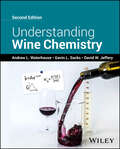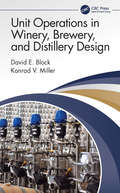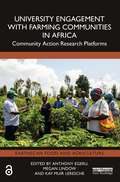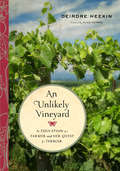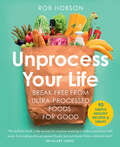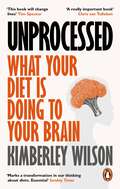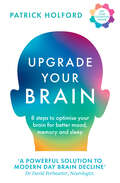- Table View
- List View
Understanding Weight Control: Mind and Body Strategies for Lifelong Success
by Deborah C. PH.DThis guide explains why we gain weight and what we can do to lose it. Without advocating any particular diet, it details a mind-body strategy for realistic lifetime weight management.Aiming to instill healthy perspectives for lifelong weight control, this book focuses on strategies that are designed to be modified and rotated throughout life to promote motivation, liveliness, and curiosity—key elements of not only losing weight but maintaining a healthy one. Each chapter is backed by the latest scientific evidence, presented in a way that is clear and understandable to readers. Emerging successful strategies are highlighted, and myths such as those developed by product and diet advertising campaigns are debunked. Understanding Weight Control: Mind and Body Strategies for Lifelong Success presents a general, science-backed plan for long-term weight management. The author explains the physical and psychological factors of weight control—why our fat cells sometimes go rogue and what habits and other factors we can control to change that. She addresses coping with the mental challenges that accompany weight loss and control and additionally shares illustrative stories from her weight loss patients as well as from her own experience.
Understanding Wine Chemistry
by David W. Jeffery Andrew L. Waterhouse Gavin L. SacksUnderstanding Wine Chemistry Understand the reactions behind the world’s most alluring beverages The immense variety of wines on the market is the product of multiple chemical processes – whether acting on components arising in the vineyard, during fermentation, or throughout storage. Winemaking decisions alter the chemistry of finished wines, affecting the flavor, color, stability, and other aspects of the final product. Knowledge of these chemical and biochemical processes is integral to the art and science of winemaking. Understanding Wine Chemistry has served as the definitive introduction to the chemical components of wine, their properties, and their reaction mechanisms. It equips the knowledgeable reader to interpret and predict the outcomes of physicochemical reactions involved with winemaking processes. Now updated to reflect recent research findings, most notably in relation to wine redox chemistry, along with new Special Topics chapters on emerging areas, it continues to set the standard in the subject. Readers of the second edition of Understanding Wine Chemistry will also find: Case studies throughout showing chemistry at work in creating different wine styles and avoiding common adverse chemical and sensory outcomes Detailed treatment of novel subjects like non-alcoholic wines, non-glass alternatives to wine packaging, synthetic wines, and more An authorial team with decades of combined experience in wine chemistry research and education Understanding Wine Chemistry is ideal for college and university students, winemakers at any stage in their practice, professionals in related fields such as suppliers or sommeliers, and chemists with an interest in wine.
Understanding Wine Chemistry (Sci (society Of Chemical Industry) Ser.)
by David W. Jeffery Andrew L. Waterhouse Gavin L. SacksUnderstanding Wine Chemistry Understand the reactions behind the world’s most alluring beverages The immense variety of wines on the market is the product of multiple chemical processes – whether acting on components arising in the vineyard, during fermentation, or throughout storage. Winemaking decisions alter the chemistry of finished wines, affecting the flavor, color, stability, and other aspects of the final product. Knowledge of these chemical and biochemical processes is integral to the art and science of winemaking. Understanding Wine Chemistry has served as the definitive introduction to the chemical components of wine, their properties, and their reaction mechanisms. It equips the knowledgeable reader to interpret and predict the outcomes of physicochemical reactions involved with winemaking processes. Now updated to reflect recent research findings, most notably in relation to wine redox chemistry, along with new Special Topics chapters on emerging areas, it continues to set the standard in the subject. Readers of the second edition of Understanding Wine Chemistry will also find: Case studies throughout showing chemistry at work in creating different wine styles and avoiding common adverse chemical and sensory outcomes Detailed treatment of novel subjects like non-alcoholic wines, non-glass alternatives to wine packaging, synthetic wines, and more An authorial team with decades of combined experience in wine chemistry research and education Understanding Wine Chemistry is ideal for college and university students, winemakers at any stage in their practice, professionals in related fields such as suppliers or sommeliers, and chemists with an interest in wine.
Unf*ckupable: 50 Recipes That Even You Can't Screw Up, a What the F*@# Should I Make for Dinner? Sequel (A What The F* Book)
by Zach GoldenAnyone -- even you -- can tackle the fifty new recipes in this irreverent anti-cookbook from the author of What the F*@# Should I Make For Dinner? Author Zach Golden has curated and honed a collection of dishes that anyone, even you, can make without screwing them up. From his first book, where he approached the dinner question with the endless variety of a Choose-Your-Own-Adventure novel, to two successive titles guiding the aimless masses towards what to drink and what to do with their lives, Golden is the master at telling other people what to do. This next book marries scaled-down kitchen techniques with satisfying outcomes, with a heavy dose of profanity and deadpan humor. Don't f*@# up any of the following: Chicken and Rice SoupRoasted Vegetable and Bacon HashFennel, Sausage, and Arugula Pasta. . . and more, delivering on delicious meals as long as you don't do anything stupid like start a grease fire, cut off a finger, or spill hot pasta water down your pants. Unless, as he says, you're really, really dumb, they're Unf*ckupable.
The Unicorn Cookbook: Magical Recipes for Lovers of the Mythical Creature
by Alix CareyThe magical realm of the mighty unicorn comes to life in this dazzling cookery book brimming with sparkles and rainbows. From the magical explosion cake to happiness pancakes, The Unicorn Cookbook is packed with recipes perfect for parties and times when all you want to do is spread some joy and release your inner unicorn.
Unicorn Food: Beautiful Plant-Based Recipes to Nurture Your Inner Magical Beast
by Kat OdellA beautiful collection of vividly colored, plant-based foods and drinks that are stunning to look at, incredibly tasty, and deceptively healthy. Grain bowls, spiralized vegetables, toasts, wraps, and more, all in a rainbow of color.
Unit Operations in Winery, Brewery, and Distillery Design
by David E. Block Konrad V. MillerUnit Operations in Winery, Brewery, and Distillery Design focuses on process design for wineries, breweries, and distilleries; and fills the need for a title that focuses on the challenges inherent to specifying and building alcoholic beverage production facilities. This text walks through the process flow of grapes to wine, grain to beer, and wine and beer to distilled spirits, with an emphasis on the underlying engineering principles, the equipment involved in these processes, and the selection and design of said equipment. Outlines the process flow of alcoholic beverage production Reviews process engineering fundamentals (mass & energy balances, fluid flow, materials receiving & preparation, heat exchange, fermentation, downstream processing, distillation, ageing, packaging, utilities, control systems, and plant layout) and their application to beverage plants Describes the idea of sanitary design and its application to plant operation and design Covers critical equipment parameters for purchasing, operating, and maintaining systems Shows how winery/brewery/distillery can influence product "style" and how "style" can dictate design Features examples of calculations derived from wineries designed by the authors, end of chapter problems, and integrative in-text problems that describe real-world issues and extend understanding Written for both engineers in the alcohol industry and non-engineers looking to understand facility design, this textbook is aimed at students, winemakers, brewers, distillers, and process engineers.
Unit Operations in Winery, Brewery, and Distillery Design
by David E. Block Konrad V. MillerUnit Operations in Winery, Brewery, and Distillery Design focuses on process design for wineries, breweries, and distilleries; and fills the need for a title that focuses on the challenges inherent to specifying and building alcoholic beverage production facilities. This text walks through the process flow of grapes to wine, grain to beer, and wine and beer to distilled spirits, with an emphasis on the underlying engineering principles, the equipment involved in these processes, and the selection and design of said equipment. Outlines the process flow of alcoholic beverage production Reviews process engineering fundamentals (mass & energy balances, fluid flow, materials receiving & preparation, heat exchange, fermentation, downstream processing, distillation, ageing, packaging, utilities, control systems, and plant layout) and their application to beverage plants Describes the idea of sanitary design and its application to plant operation and design Covers critical equipment parameters for purchasing, operating, and maintaining systems Shows how winery/brewery/distillery can influence product "style" and how "style" can dictate design Features examples of calculations derived from wineries designed by the authors, end of chapter problems, and integrative in-text problems that describe real-world issues and extend understanding Written for both engineers in the alcohol industry and non-engineers looking to understand facility design, this textbook is aimed at students, winemakers, brewers, distillers, and process engineers.
United States of Bread: Our Nation's Homebaking Heritage: from Sandwich Loaves to Sourdough
by Adrienne KaneAs American as apple pie? How about As American as freshly baked bread?. Before we became reliant on massed-produced supermarket loaves, The United States had a rich history of homemade bread recipes, from flaky and light Southern biscuits to hearty Boston Brown Bread -not to mention the uniquely tangy San Francisco Sourdough. Adrienne Kane has unearthed these vintage recipes, given them a modern twist where appropriate, and collected them all in United States of Bread. Both novices and experienced bakers can delight in these American favorites, including Pullman Loaves, Amish Dill, Cinnamon Raisin Swirl, New York Flatbread, Wild Rice Bread Stuffing, and lots more. United States of Bread is a charming collection that will inspire everyone to get in the kitchen to celebrate America's home-baking legacy.
University Engagement with Farming Communities in Africa: Community Action Research Platforms (Earthscan Food and Agriculture)
by Anthony EgeruThis book explains and explores how collaborations can be built and strengthened between African universities and farming communities to address real-world contemporary challenges. The book focuses on Community Action Research Platforms, an approach that has successfully enabled African universities to break free of the ivory tower and prove their relevance to society through deep collaborative engagements in targeted agricultural value chains. Developed in a pan-African network of universities (RUFORUM) focused on capacity building in agriculture, the approach has been tested in diverse settings over the last 15 years. The book draws on the experiences and lessons from 21 different projects initiated by RUFORUM member universities in Benin, Botswana, Ethiopia, Ghana, Kenya, Malawi, Namibia, South Africa, Sudan, Tanzania, Uganda and Zimbabwe. It highlights a critical yet underutilised role for African universities as collaborators and catalysts for multisector solutions. These are solutions that increase productivity and address climate change. They develop livelihoods and resilience in rural communities, as well as promote farmers’ access to markets, innovation and trade while safeguarding biodiversity and enhancing food and nutrition security. The book makes a case for repositioning African universities as fulcrums of development in society. It shares the rich experiences, learnings and scientific findings of diverse researchers, practitioners and students who have been working towards achieving this reality on the ground. This multidisciplinary book holds appeal for university leaders, higher education, agrifood and development specialists, researchers and practitioners, policymakers and development agencies engaged in African agriculture and rural development, higher education and sustainable growth.
University Engagement with Farming Communities in Africa: Community Action Research Platforms (Earthscan Food and Agriculture)
This book explains and explores how collaborations can be built and strengthened between African universities and farming communities to address real-world contemporary challenges. The book focuses on Community Action Research Platforms, an approach that has successfully enabled African universities to break free of the ivory tower and prove their relevance to society through deep collaborative engagements in targeted agricultural value chains. Developed in a pan-African network of universities (RUFORUM) focused on capacity building in agriculture, the approach has been tested in diverse settings over the last 15 years. The book draws on the experiences and lessons from 21 different projects initiated by RUFORUM member universities in Benin, Botswana, Ethiopia, Ghana, Kenya, Malawi, Namibia, South Africa, Sudan, Tanzania, Uganda and Zimbabwe. It highlights a critical yet underutilised role for African universities as collaborators and catalysts for multisector solutions. These are solutions that increase productivity and address climate change. They develop livelihoods and resilience in rural communities, as well as promote farmers’ access to markets, innovation and trade while safeguarding biodiversity and enhancing food and nutrition security. The book makes a case for repositioning African universities as fulcrums of development in society. It shares the rich experiences, learnings and scientific findings of diverse researchers, practitioners and students who have been working towards achieving this reality on the ground. This multidisciplinary book holds appeal for university leaders, higher education, agrifood and development specialists, researchers and practitioners, policymakers and development agencies engaged in African agriculture and rural development, higher education and sustainable growth.
An Unlikely Vineyard: The Education of a Farmer and Her Quest for Terroir
by Deirdre Heekin Alice FeiringNamed one of the Best Wine Books of 2014 by The New York Times, An Unlikely Vineyard tells the evolutionary story of Deirdre Heekin’s farm from overgrown fields to a fertile, productive, and beautiful landscape that melds with its natural environment. Is it possible to capture landscape in a bottle? To express its terroir, its essence of place—geology, geography, climate, and soil—as well as the skill of the winegrower? That’s what Heekin and her chef/husband, Caleb Barber, set out to accomplish on their tiny, eight-acre hillside farm and vineyard in Vermont. But An Unlikely Vineyard involves much more. It also presents, through the example of their farming journey and winegrowing endeavors, an impressive amount of information on how to think about almost every aspect of gardening: from composting to trellising; from cider and perry making to growing old garden roses, keeping bees, and raising livestock; from pruning (or not) to dealing naturally with pests and diseases. As Eric Asimov, chief wine critic for The New York Times, writes, “I love this book, which conveys beautifully why the best wine is, at heart, an agricultural expression.” Challenged by cold winters, wet summers, and other factors, Deirdre and Caleb set about to grow not only a vineyard, but an orchard of heirloom apples, pears, and plums, as well as gardens filled with vegetables, herbs, roses, and wildflowers destined for their own table and for the kitchen of their small restaurant. They wanted to create, or rediscover, a sense of place, and to grow food naturally using the philosophy and techniques gleaned from organic gardening, permaculture, and biodynamic farming. Accompanied throughout by lush photos, this gentle narrative will appeal to anyone who loves food, farms, and living well.
The Unofficial Bridgerton Book of Afternoon Tea
by Katherine BeboOver 65 afternoon tea recipes to celebrate the scandal, the sauce and the sumptuous spreads of binge-worthy regency drama hit Bridgerton.Bridgerton fans are cordially invited to indulge in themed afternoon teas galore. Each character hosts their own imagined chapter, serving up tasty treats to complement their theme. Penelope ― with her bright, blossoming frocks ― will be offering up a floral spread, while Genevieve Delacroix goes all ooh là là with her ‘French’ accent and Parisian petit fours. Only the daintiest delights will do for Daphne Bridgerton, while devilishly delicious is the order of the day for smouldering Simon ― ‘I Burn For You’ Biscuits, anyone? Queen Charlotte’s tea is positively eccentric, while Lord Featherington’s errs on the boozy side... Audiences couldn’t get enough of the drama, deception and, indeed, Duke’s derrière. And they won’t be able to get enough of the elegant savouries, scones, cakes, macarons and other delectable recipes for indulgences here that accompany this seriously extravagant period drama with a twist.
Unprocess Your Life: Break Free From Ultra-processed Foods For Good
by Rob Hobson‘This brilliant book is the answer for anyone wanting to make a profound shift away from eating ultra-processed foods, but just doesn’t know where to start’ – Dr Hilary Jones
Unprocessed: How the Food We Eat Is Fuelling Our Mental Health Crisis
by Kimberley WilsonWe all know that as a nation our mental health is in crisis. But what most don't know is that a critical ingredient in this debate, and a crucial part of the solution - what we eat - is being ignored.Nutrition has more influence on what we feel, who we become and how we behave than we could ever have imagined. It affects everything from our decision-making to aggression and violence. Yet mental health disorders are overwhelmingly treated as 'mind' problems as if the physical brain - and how we feed it - is irrelevant. Someone suffering from depression is more likely to be asked about their relationship with their mother than their relationship with food.In this eye-opening and impassioned book, psychologist Kimberley Wilson draws on startling new research - as well as her own work in prisons, schools and hospitals around the country - to reveal the role of food and nutrients in brain development and mental health: from how the food a woman eats during pregnancy influences the size of her baby's brain, and hunger makes you mean; to how nutrient deficiencies change your personality.We must also recognise poor nutrition as a social injustice, with the poorest and most vulnerable being systematically ignored. We need to talk about what our food is doing to our brains. And we need decisive action, not over rehearsed soundbites and empty promises, from those in power - because if we don't, things can only get worse.
Unsavory Truth: How Food Companies Skew the Science of What We Eat
by Marion NestleA James Beard Award-winner and the author of What to Eat and Soda Politics, leading nutritionist Marion Nestle exposes how the food industry corrupts scientific research for profit. Is chocolate heart-healthy? Does yogurt prevent type 2 diabetes? Do pomegranates help cheat death? News accounts bombard us with such amazing claims, report them as science, and influence what we eat. Yet, as Marion Nestle explains, these studies are more about marketing than science; they are often paid for by companies that sell those foods. Whether it's a Coca-Cola-backed study hailing light exercise as a calorie neutralizer, or blueberry-sponsored investigators proclaiming that this fruit prevents erectile dysfunction, every corner of the food industry knows how to turn conflicted research into big profit. As Nestle argues, it's time to put public health first. Written with unmatched rigor and insight, Unsavory Truth reveals how the food industry manipulates nutrition science -- and suggests what we can do about it.
Upgrade Your Brain: Unlock Your Life’s Full Potential
by null Patrick HolfordDo you often feel exhausted and negative? Do you spend your days feeling tired and wired? Your nights unable to fall asleep easily, or without a drink? Do you wake up anxious and stressed and in need a coffee to get going? Do you forget what you were doing, forget people’s names and where you put things? Is your mental acuity and memory slipping? Are you concerned about your memory or mental wellbeing? Something depressing is happen to humanity, and possibly even you. Our brains are degenerating and – in parallel – we’re seeing a worrying increase in mental illness across the world. Rates of anxiety, depression, dementia, ADHD and autism are all increasing at an alarming rate across the globe. According to the World Health Organisation, our declining brain health is the greatest threat we face – more than cancer, diabetes or obesity. Individually and collectively,though, we can optimise our brain health and cognitive function – to improve mood, memory, stress resilience, sleep and ability to focus. How? By understanding the powerful effects that nutrition and other holistic lifestyle factors can have on our brains. In Upgrade Your Brain, bestselling author Patrick Holford will draw on his 40 years’ of expertise – as well as countless experts from around the world – to teach us all how to reverse the tide.
Urban Appetites: Food and Culture in Nineteenth-Century New York (Historical Studies of Urban America)
by Cindy R. LobelGlossy magazines write about them, celebrities give their names to them, and you’d better believe there’s an app (or ten) committed to finding you the right one. They are New York City restaurants and food shops. And their journey to international notoriety is a captivating one. The now-booming food capital was once a small seaport city, home to a mere six municipal food markets that were stocked by farmers, fishermen, and hunters who lived in the area. By 1890, however, the city’s population had grown to more than one million, and residents could dine in thousands of restaurants with a greater abundance and variety of options than any other place in the United States. Historians, sociologists, and foodies alike will devour the story of the origins of New York City’s food industry in Urban Appetites. Cindy R. Lobel focuses on the rise of New York as both a metropolis and a food capital, opening a new window onto the intersection of the cultural, social, political, and economic transformations of the nineteenth century. She offers wonderfully detailed accounts of public markets and private food shops; basement restaurants and immigrant diners serving favorites from the old country; cake and coffee shops; and high-end, French-inspired eating houses made for being seen in society as much as for dining. But as the food and the population became increasingly cosmopolitan, corruption, contamination, and undeniably inequitable conditions escalated. Urban Appetites serves up a complete picture of the evolution of the city, its politics, and its foodways.
Urban Appetites: Food and Culture in Nineteenth-Century New York (Historical Studies of Urban America)
by Cindy R. LobelGlossy magazines write about them, celebrities give their names to them, and you’d better believe there’s an app (or ten) committed to finding you the right one. They are New York City restaurants and food shops. And their journey to international notoriety is a captivating one. The now-booming food capital was once a small seaport city, home to a mere six municipal food markets that were stocked by farmers, fishermen, and hunters who lived in the area. By 1890, however, the city’s population had grown to more than one million, and residents could dine in thousands of restaurants with a greater abundance and variety of options than any other place in the United States. Historians, sociologists, and foodies alike will devour the story of the origins of New York City’s food industry in Urban Appetites. Cindy R. Lobel focuses on the rise of New York as both a metropolis and a food capital, opening a new window onto the intersection of the cultural, social, political, and economic transformations of the nineteenth century. She offers wonderfully detailed accounts of public markets and private food shops; basement restaurants and immigrant diners serving favorites from the old country; cake and coffee shops; and high-end, French-inspired eating houses made for being seen in society as much as for dining. But as the food and the population became increasingly cosmopolitan, corruption, contamination, and undeniably inequitable conditions escalated. Urban Appetites serves up a complete picture of the evolution of the city, its politics, and its foodways.
Urban Appetites: Food and Culture in Nineteenth-Century New York (Historical Studies of Urban America)
by Cindy R. LobelGlossy magazines write about them, celebrities give their names to them, and you’d better believe there’s an app (or ten) committed to finding you the right one. They are New York City restaurants and food shops. And their journey to international notoriety is a captivating one. The now-booming food capital was once a small seaport city, home to a mere six municipal food markets that were stocked by farmers, fishermen, and hunters who lived in the area. By 1890, however, the city’s population had grown to more than one million, and residents could dine in thousands of restaurants with a greater abundance and variety of options than any other place in the United States. Historians, sociologists, and foodies alike will devour the story of the origins of New York City’s food industry in Urban Appetites. Cindy R. Lobel focuses on the rise of New York as both a metropolis and a food capital, opening a new window onto the intersection of the cultural, social, political, and economic transformations of the nineteenth century. She offers wonderfully detailed accounts of public markets and private food shops; basement restaurants and immigrant diners serving favorites from the old country; cake and coffee shops; and high-end, French-inspired eating houses made for being seen in society as much as for dining. But as the food and the population became increasingly cosmopolitan, corruption, contamination, and undeniably inequitable conditions escalated. Urban Appetites serves up a complete picture of the evolution of the city, its politics, and its foodways.
Urban Appetites: Food and Culture in Nineteenth-Century New York (Historical Studies of Urban America)
by Cindy R. LobelGlossy magazines write about them, celebrities give their names to them, and you’d better believe there’s an app (or ten) committed to finding you the right one. They are New York City restaurants and food shops. And their journey to international notoriety is a captivating one. The now-booming food capital was once a small seaport city, home to a mere six municipal food markets that were stocked by farmers, fishermen, and hunters who lived in the area. By 1890, however, the city’s population had grown to more than one million, and residents could dine in thousands of restaurants with a greater abundance and variety of options than any other place in the United States. Historians, sociologists, and foodies alike will devour the story of the origins of New York City’s food industry in Urban Appetites. Cindy R. Lobel focuses on the rise of New York as both a metropolis and a food capital, opening a new window onto the intersection of the cultural, social, political, and economic transformations of the nineteenth century. She offers wonderfully detailed accounts of public markets and private food shops; basement restaurants and immigrant diners serving favorites from the old country; cake and coffee shops; and high-end, French-inspired eating houses made for being seen in society as much as for dining. But as the food and the population became increasingly cosmopolitan, corruption, contamination, and undeniably inequitable conditions escalated. Urban Appetites serves up a complete picture of the evolution of the city, its politics, and its foodways.
Urban Appetites: Food and Culture in Nineteenth-Century New York (Historical Studies of Urban America)
by Cindy R. LobelGlossy magazines write about them, celebrities give their names to them, and you’d better believe there’s an app (or ten) committed to finding you the right one. They are New York City restaurants and food shops. And their journey to international notoriety is a captivating one. The now-booming food capital was once a small seaport city, home to a mere six municipal food markets that were stocked by farmers, fishermen, and hunters who lived in the area. By 1890, however, the city’s population had grown to more than one million, and residents could dine in thousands of restaurants with a greater abundance and variety of options than any other place in the United States. Historians, sociologists, and foodies alike will devour the story of the origins of New York City’s food industry in Urban Appetites. Cindy R. Lobel focuses on the rise of New York as both a metropolis and a food capital, opening a new window onto the intersection of the cultural, social, political, and economic transformations of the nineteenth century. She offers wonderfully detailed accounts of public markets and private food shops; basement restaurants and immigrant diners serving favorites from the old country; cake and coffee shops; and high-end, French-inspired eating houses made for being seen in society as much as for dining. But as the food and the population became increasingly cosmopolitan, corruption, contamination, and undeniably inequitable conditions escalated. Urban Appetites serves up a complete picture of the evolution of the city, its politics, and its foodways.
Urban Appetites: Food and Culture in Nineteenth-Century New York (Historical Studies of Urban America)
by Cindy R. LobelGlossy magazines write about them, celebrities give their names to them, and you’d better believe there’s an app (or ten) committed to finding you the right one. They are New York City restaurants and food shops. And their journey to international notoriety is a captivating one. The now-booming food capital was once a small seaport city, home to a mere six municipal food markets that were stocked by farmers, fishermen, and hunters who lived in the area. By 1890, however, the city’s population had grown to more than one million, and residents could dine in thousands of restaurants with a greater abundance and variety of options than any other place in the United States. Historians, sociologists, and foodies alike will devour the story of the origins of New York City’s food industry in Urban Appetites. Cindy R. Lobel focuses on the rise of New York as both a metropolis and a food capital, opening a new window onto the intersection of the cultural, social, political, and economic transformations of the nineteenth century. She offers wonderfully detailed accounts of public markets and private food shops; basement restaurants and immigrant diners serving favorites from the old country; cake and coffee shops; and high-end, French-inspired eating houses made for being seen in society as much as for dining. But as the food and the population became increasingly cosmopolitan, corruption, contamination, and undeniably inequitable conditions escalated. Urban Appetites serves up a complete picture of the evolution of the city, its politics, and its foodways.
Urban Expansion and Food Security in New Zealand: The Collapse of Local Horticulture (Routledge Studies in Food, Society and the Environment)
by Benjamin Felix RichardsonThis book examines suburban development in New Zealand and its conflict with and impact on local horticulture and food security. Drawing on an ethnographic study of Auckland’s rapidly expanding urban periphery, combined with comparative case studies from California in the USA and Victoria in Australia, the book examines how the profit-making strategies of property developers and landowners drastically reshapes work and life at the edge of cities. With a significant portion of the world's croplands lying adjacent to cities, the accelerating pace of urban sprawl across the planet places unprecedented pressure on the productivity and even existence of these vital food bowl regions. The book examines how the demand for more land for development at the urban periphery collides with concerns over local food security and the protection of ecosystem services. It analyses land use policy, historical records, and physical patterns of development, alongside participant observation of local events. It combines this with interviews with government officials, property developers, landowners, local residents and horticulturists. By combining these narratives of the hectic and lucrative business of suburban property development with the collapse of local horticulture, this book shows how the realignment of the New Zealand's interests of financial profitability over other concerns led to the transformation of urban peripheries from a productive food bowl to an investment vehicle. This book will be of great interest to students and scholars of urban food and agriculture, urban planning and development and rural-urban studies.
Urban Expansion and Food Security in New Zealand: The Collapse of Local Horticulture (Routledge Studies in Food, Society and the Environment)
by Benjamin Felix RichardsonThis book examines suburban development in New Zealand and its conflict with and impact on local horticulture and food security. Drawing on an ethnographic study of Auckland’s rapidly expanding urban periphery, combined with comparative case studies from California in the USA and Victoria in Australia, the book examines how the profit-making strategies of property developers and landowners drastically reshapes work and life at the edge of cities. With a significant portion of the world's croplands lying adjacent to cities, the accelerating pace of urban sprawl across the planet places unprecedented pressure on the productivity and even existence of these vital food bowl regions. The book examines how the demand for more land for development at the urban periphery collides with concerns over local food security and the protection of ecosystem services. It analyses land use policy, historical records, and physical patterns of development, alongside participant observation of local events. It combines this with interviews with government officials, property developers, landowners, local residents and horticulturists. By combining these narratives of the hectic and lucrative business of suburban property development with the collapse of local horticulture, this book shows how the realignment of the New Zealand's interests of financial profitability over other concerns led to the transformation of urban peripheries from a productive food bowl to an investment vehicle. This book will be of great interest to students and scholars of urban food and agriculture, urban planning and development and rural-urban studies.

